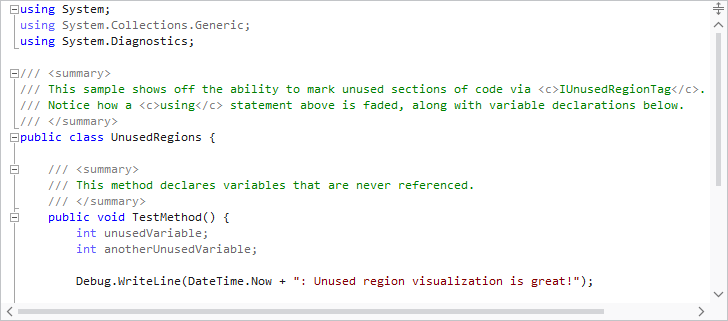Syntax Highlighting
The document text rendered within a view is drawn using two adornment layers, one for the text itself and normal decorations (underlines, etc.), and one for any text backgrounds. Classification taggers can be applied to a document (via language services) to override the default syntax highlighting provided by a language's lexer. This adds support for features like changing the foreground color of certain words, marking search result ranges in a different background color, etc.
Text Rendering Layers
Syntax highlighting is divided into two adornment layers: foreground and background. A reference to the text foreground can be obtained via the AdornmentLayerDefinitions.TextForeground property and a reference to the text background can be obtained via the AdornmentLayerDefinitions.TextBackground property.
The background is separated out so that the selection layer can overlay the text background when the selection extends to text ranges that have a background set.
Important
The two text rendering layers cannot be returned via the ITextView.GetAdornmentLayer method. If you wish to add custom adornments around text, you should make your own adornment layer and order it relative to the built-in adornment layers.
Lexer-Based Syntax Highlighting
Syntax languages almost always have a lexer in place that is able to tokenize text. A token tagger can then be used to provide classification tag ranges for the lexer's tokens, where the classification tags indicate a logical IClassificationType for the contained text. The text rendering layers watch the classification tags that are provided by the token tagger.
Each IClassificationType can be paired with a highlighting style, via a highlighting style registry. Once there is a mapping between classification types and highlighting styles, the text rendering layers know how each classified range should be rendered.
Thus, with the pieces above in place, lexer-based syntax highlighting is achieved.
Overriding Syntax Highlighting
Sometimes it is desirable to override default lexer-based highlighting. Instances of this could be where certain text ranges should be rendered in a specific foreground, such as when highlighting type names in C# code. Or perhaps changing the background color of certain ranges to indicate breakpoints or find results.
As mentioned above, the text rendering layers already use a tag aggregator to watch for updates to IClassificationTag ranges. When updates occur, the text is repainted. Classification taggers (implementations of ITagger<IClassificationTag>) can be ordered. It is very important that classification taggers are set to be ordered before the TaggerKeys.Token tagger, which is the key for the lexer-based syntax highlighting. Otherwise, the syntax highlighting derived from the classification tag ranges will appear under the lexer-based syntax highlighting, where it likely would not be seen.
Several QuickStarts show how to implement taggers that alter syntax highlighting.
Unused Regions
It's sometimes handy to render certain portions of code semi-transparently, such as unused code or regions of code that will not execute due to conditional compilation.

Several unused regions
SyntaxEditor provides a special IUnusedRegionTag that can be provided over text ranges (via an ITagger<IUnusedRegionTag> implementation) that should be considered unused. The text rendering logic uses an internal tag aggregator to watch for those tagged regions and renders contained text in a semi-transparent foreground, while retaining the default syntax highlighting that was applied to the text.
See the Taggers and Tagger Providers topic for more information on tagging.
The default rendering opacity for unused regions is 70%. This value may be altered by changing the IHighlightingStyleRegistry.UnusedRegionForegroundOpacity property.